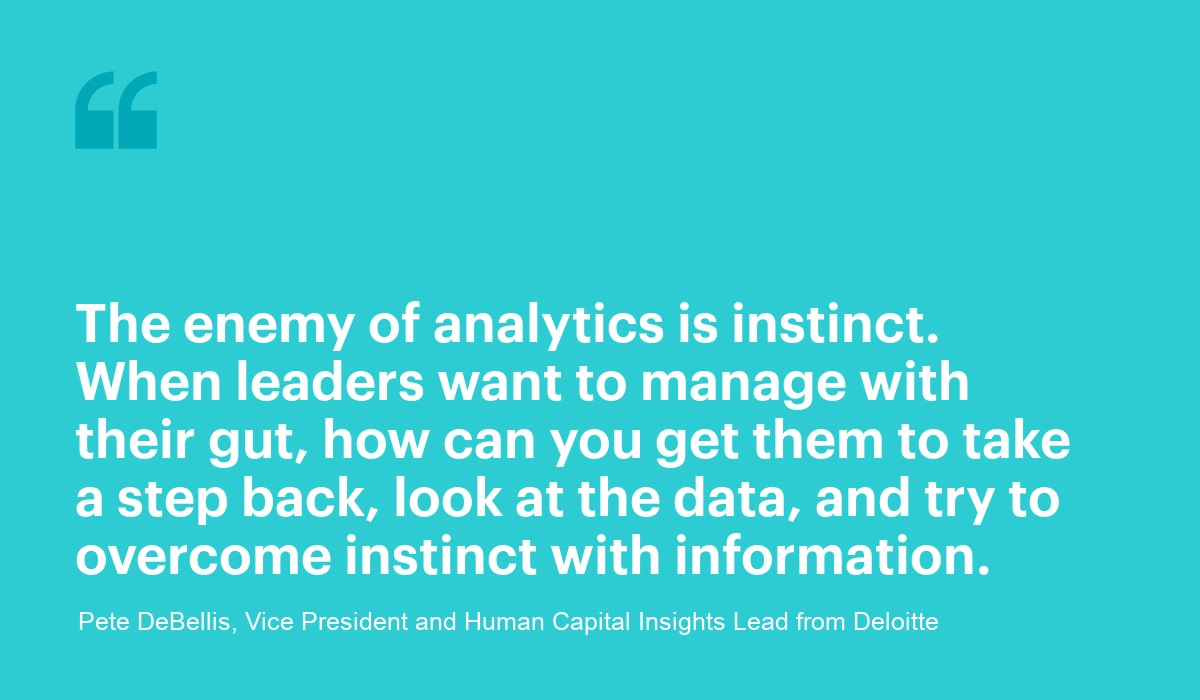Human Resource? How About The Human Truth
Having the right talent is a huge differentiator for companies, but how do you leverage your greatest asset? Unlock The Human Truth.

Learn some of the highlights from Paul Rubenstein, Pete DeBellis, Matthew Hamiton, and Mark Smith which they shared at the joint Deloitte-Visier webinar, Building the Foundation of a People-Powered Organization.
People are not commodities
The world has changed and it’s not going back. Workforce shortage trends and social issues have been brewing for a while. “People analytics has gone from a nice to have to a must have. Gone from an HR thing to a people manager thing,” say Paul Rubenstein, Chief People Officer at Visier.
“The only way to make high quality decisions is a people manager that sees not just what’s in front of you or what’s in your HRIS, but a deeper human truth about the person who potentially you’re trying to unlock.”
Employees need to be at the center of decision making, not an afterthought that’s layered on later on. People are unique, and how companies leverage and understand employees is a significant differentiator.
Let’s start with the basic reality that people are not a fungible resource. Matthew Hamilton, Head of HR Strategy & People Analytics at Protective Life Insurance Company uses the NFL as a good example. “They compete under the exact same rules. They have the exact same pool of talent available to them. They have the same resources. They’ve got salary caps in the NFL. From one viewpoint it is extremely consistent. So why would you expect one team to dominate over others? It’s that [the best coaches are] able to leverage, bring together the right skills and the right people consistently and over time. They’re leveraging that capacity.” Skilled coaches don’t treat players as interchangeable, and there’s no reason companies should either.

Never before have people been more critical to business success. Get ready for the future of work by watching Outsmart on demand.
Collaborating with Finance
Employees do cost a significant portion of any organization’s operating budget. “In some industries, people are going to make up 60%, 70%, 80% of the company’s expenses, depending on how material versus knowledge workforce they are,” Matthew says. While he argues that people are not a commodity, there’s no disagreement that employee metrics affect financial ones. When it comes to partnering with Finance, Pete DeBellis, Vice President and Human Capital Insights Lead from Deloitte says, “collaboration is chicken soup for the soul.”
Visier research shows that a critical success factor to increasing adoption with people analytics is alignment between people analytics and the finance team. Mark Smith, Vice President of Workforce Strategy and Analytics at Providence sees a huge benefit to this kind of collaboration. “I had a very recent experience where our strategic finance group had been trying to understand what does it look like to ramp up more in hiring, and what would that mean in agency reduction? The finance team had some data points. We had some of the data points, and the finance team reached out and explained what they were trying to accomplish. We came to the conclusion that they had a brand new pair of roller skates. We had the lock and key.” Both sides had data the other needed.
Acting on data instead of gut
People analytics enables companies to act on data-driven insights instead of on hunches. “The enemy of analytics is instinct,” Pete says. When leaders want to manage with their gut, how can you get them to take a step back, look at the data, and try to overcome instinct with information? For many people, relying on people analytics is a new idea. “The key word that I’ve heard in the past that helps us cue in when somebody is doing that is when they say, ‘In my experience’,” says Matthew.

Matthew gives an example of how that hunches can be off. An onboarding program at Protective Life significantly reduced new hire turnover in the first 90 days. Not all managers were using the onboarding program as well as others; some were balking because it wasn’t something they’d done before and they didn’t think it would work. He was able to prove to them that if they followed the program, their new hire retention results would improve. Having solid data cut the legs out from under excuses that blamed other variables. Paul says, “I think what this does is hold a mirror up to both individual and collective decisions in a new way.” By showing individual managers how their actions affect outcomes at both a small and company-wide level, you empower them to make better decisions.
The real impact starts with managers
A company can only be strengthened when its managers are given the tools they need to make data-driven insights. So much of what happens at the company happens at the front line level. For example, a CEO can convey a desire to lead the company to be more inclusive, but the most dramatic differences are going to happen at a managerial level. Everyone has hiring biases. Have the managers undergone training to overcome those biases? A CEO’s good intent needs to be enabled at the managerial level.
As head of HR, Paul had an example of when someone came into his office concerned because someone on their team resigned. Since it was the second person who had resigned, they were worried it was a trend and wanted a bigger picture. “We were able to take a look at it. We found that it was just two career levels that were driving way more than half of our turnover. It made total sense when you looked at the data from 50,000 feet,” Paul says. When they dug into who was driving the number it was a question of taking that insight and turning it into action. This is true of every business problem. HR can provide guidance, but it’s the front-line managers that really move change. “Everyone thinks HR is going to solve turnover. No way. The real work happens at the manager-employee moment of truth, and the only way to get in there is to give people good insights on what’s important or not so that they can again see the signal through the noise.”

Want to learn more about why people analytics is more important than ever? Watch the recording of this joint Deloitte-Visier webinar, Building the Foundation of a People-Powered Organization, to hear four experts delve deeper into this topic.


